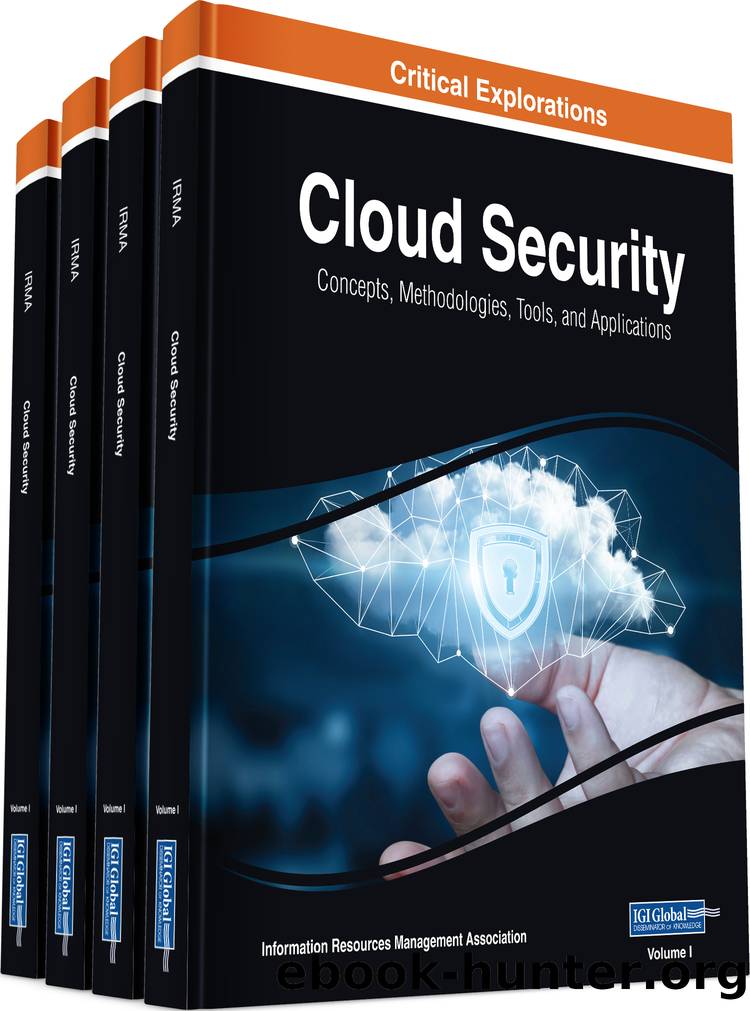Cloud Security: Concepts, Methodologies, Tools, and Applications by Management Association Information Resources

Author:Management Association Information Resources
Language: eng
Format: epub
Publisher: Engineering Science Reference
The existing data storage auditing methods can be further classified into several categories according to:
1. The Type of the Auditor/Verifier: Public auditing or private auditing.
2. The Distribution of Data to be Audited: Single-copy or multiple-copy data.
3. The Data Persistence: Static or dynamic data.
Public Auditing vs. Private Auditing
Considering the role of the auditor in the auditing model, data storage auditing schemes fall into two categories; private auditing and pubic auditing (Zheng & Xu, 2012). In private auditing, only data owners can challenge the CSS to verify the correctness of their outsourced data (Yang & Jia, 2012).Unfortunately, private auditing schemes have two limitations: (a) They impose an online burden on the data owner to verify data integrity and (b) The data owner must have huge computational capabilities for auditing. Examples of auditing schemes that only support private auditing are (Chen & Curtmola, 2012; Chen & Curtmola, 2013; Mukundan, Madria, & Linderman, 2012; Etemad & Kupcu, 2013). In public auditing or third party auditing (Zhu, Ahn, Hu, Yau, An, & Hu, 2013), data owners are able to delegate the auditing task to an independent third party auditor (TPA), without the devotion of their computational resources. However, pubic auditing schemes should guarantee that the TPA keeps no private information about the verified data. Several variations of PDP schemes that support public auditing such as (Chen & Curtmola, 2013; Mukundan, Madria, & Linderman, 2012; Fujisaki & Okamoto, 1999; Abo-alian, Badr, & Tolba, 2015), were proposed under different cryptographic primitives.
Auditing Single-Copy vs. Multiple-Copy Data
For verifying the integrity of outsourced data in the cloud storage, various auditing schemes have been proposed which can be categorized into:
1. Auditing schemes for single-copy data.
2. Auditing schemes for multiple-copy data.
Download
This site does not store any files on its server. We only index and link to content provided by other sites. Please contact the content providers to delete copyright contents if any and email us, we'll remove relevant links or contents immediately.
Algorithms of the Intelligent Web by Haralambos Marmanis;Dmitry Babenko(8517)
Test-Driven Development with Java by Alan Mellor(7343)
Data Augmentation with Python by Duc Haba(7244)
Principles of Data Fabric by Sonia Mezzetta(6989)
Learn Blender Simulations the Right Way by Stephen Pearson(6923)
Microservices with Spring Boot 3 and Spring Cloud by Magnus Larsson(6754)
RPA Solution Architect's Handbook by Sachin Sahgal(6161)
Hadoop in Practice by Alex Holmes(6028)
Jquery UI in Action : Master the concepts Of Jquery UI: A Step By Step Approach by ANMOL GOYAL(5868)
The Infinite Retina by Robert Scoble Irena Cronin(5860)
Big Data Analysis with Python by Ivan Marin(5689)
Life 3.0: Being Human in the Age of Artificial Intelligence by Tegmark Max(5396)
Pretrain Vision and Large Language Models in Python by Emily Webber(4649)
Infrastructure as Code for Beginners by Russ McKendrick(4432)
WordPress Plugin Development Cookbook by Yannick Lefebvre(4163)
Functional Programming in JavaScript by Mantyla Dan(4119)
The Age of Surveillance Capitalism by Shoshana Zuboff(4108)
Embracing Microservices Design by Ovais Mehboob Ahmed Khan Nabil Siddiqui and Timothy Oleson(3954)
Applied Machine Learning for Healthcare and Life Sciences Using AWS by Ujjwal Ratan(3925)
